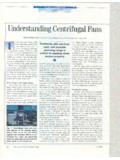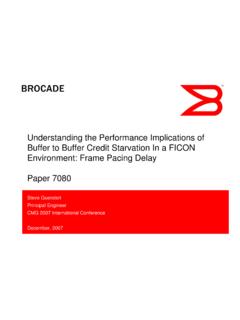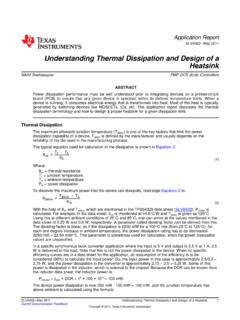Transcription of Understanding the physics of bungee jumping - …
1 The physics ofbungee jumpingAndr e Heck1, Peter Uylings1,2and Ewa K edzierska11 AMSTEL Institute, University of Amsterdam, Amsterdam, The Netherlands2 Bonhoeffercollege, Castricum, The mass phenomena like the motion of a falling chain, the behaviourof a falling elastic bar or spring, and the motion of a bungee jumper surprisemany a physicist. In this article we discuss the first phase of bungee jumping ,when the bungee jumper falls, but the bungee rope is still slack. Ininstructional material this phase is often considered a free fall, but when themass of the bungee rope is taken into account, the bungee jumper reachesacceleration greater thang. This result is contrary to the usual experiencewith free falling objects and therefore hard to believe for many a person, evenan experienced physicist.
2 It is often a starting point for heated discussionsabout the quality of the experiments and the physics knowledge of theexperimentalist, or it may even prompt complaints about the quality ofcurrent physics education. But experiments do reveal the truth and studentscan do them supported by information and communication technology (ICT)tools. We report on a research project done by secondary school students anduse their work to discuss how measurements with sensors, video analysis ofself-recorded high-speed video clips and computer modelling allow study ofthe physics of bungee article features online multimedia enhancementsThe thrilling physics of bungee jumpingLeaping from a tall structure such as a crane ora bridge to which the jumper is attached by hisor her ankles by a large rubber band is a thrillingexperience.
3 This event, better known as bungeejumping, can also serve as an intriguing context forphysics lessons and practical work [1,2]. Physicscan help to give answers to safety questions like How do I know that the rubber band has the rightlength and strength for my jump? and How amI sure that theg-forces are kept low enough thatbungee jumping does not hurt? A simple energy model of a bungee jump canbe used to generate strain guidelines and practicaldesign equations for the sizing of an all-rubberbungee rope [3]. In many studies ( , [1,4 6]),the motion is considered one dimensional, the ropeis modelled as a massless elastic, the jumper isreplaced by a point mass, aerodynamic effects areignored, and the stress strain curve of the rope isassumed linear ( , Hooke s law applies).
4 Thebungee jump can then be divided into three phases:(i) a free fall (with acceleration of gravityg)ofthejumper when the rope is still slack; (ii) the stretchphase until the rope reaches its maximum length;0031-9120/10/010063+10$ 2010 IOP Publishing LtdPHYSICSEDUCATION45(1)63A Hecket aland (iii) the rebound phase, consisting of a dampedoscillatory assumptions in this model of bungeejumping can be removed so that the results ofmodels and experiments are in better and Hubbard [7] included the effectsof the elastic properties of the rope, jumper airdrag, and jumper push-off. Strnad [8] describeda theoretical model of a bungee jump that takesonly the mass of the bungee rope into account. Thefirst phase of bungee jumping can also be related toother phenomena such as the dynamics of a falling,perfectly flexible chain suspended at one end andreleased with the two ends near to each other atthe same vertical elevation [9 14].
5 Experiments,numerical simulations, and analytical modelsdiscussed in the literature (also for discrete modelsof chains) point to the paradoxical phenomenonthat the tip of a freely falling, tightly folded chainwith one end suspended from a rigid supportmoves faster than a free falling body under phenomenon is the main subject of thisarticle, but we place it in the context of a researchproject of secondary school students and discusshow technology can contribute to the realizationof such challenging practical secondary school student projectIn the Dutch examination programme of seniorsecondary education, which is organized inso-called profiles consisting of fixed subjectcombinations.
6 Students are required to build upan examination portfolio by carrying out somesmall practical investigation tasks and one ratherlarge (80 h), cross-disciplinary research or the Nature and Health and Nature and Technology profiles, teams of twostudents may collaborate in creating their piece ofwork as independent experimental research on atopic of their own 2003, Niek Dubbelaar and Remco Brantjes,who were two secondary school students fromthe Bonhoeffer college in Amsterdam, teamedup to investigate the physics of bungee jumping ,triggered by their own interest and an article [4] particular,theywere intrigued by the alleged greater thangacceleration of a bungee jumper and, during theirexperimental work, they contacted one of theauthors of a published paper on this subject [14]
7 For more students formulated the following re-search question: How large is the acceleration ina bungee jump and to what degree is this acceler-ation influenced by the relative mass of the ropeand the jumper? Using the analogy of the mo-tion of a bullwhip, they hypothesized that the ac-celeration would be greater thangand that this ef-fect would be more dramatic if the rope was rel-atively heavy as compared with the jumper. Theycollected position time data through video mea-surements on a dropped scale model (an ActionMan toy figure) and on dropped wooden blocks ofvarious weights attached to ropes of various stiff-nesses. Figure1is a sketch of the experimentalsetting, taken from the students velocity and acceleration of the droppedobject were computed by numerical differentia-tion.
8 Soon the students realized that the mass ra-tio between rope and objects was too low to see aclear result and they repeated the experiment withobjects of larger mass ratio. The graph of the ac-celeration at the moment that the block has fallena distance equal to the rest length of the elastic asa function of the mass ratio of the elastic and theblock is shown in figure2, together with the graphof the following theoretical result:a=g(1+ (4+ )8),(1)where is the mass ratio of the elastic and thewooden block. This formula can be found in [14]and on the Internet [15]. The students noted thatthe graphs obtained by measurement and theoryare alike, with the theoretical values just a bithigher. They attributed the difference mainly tothe development of heat during the knowing that a Dutch physics teacherhad published around the same time on anexperimental verification of the physics of bungeejumping [16], the students wrote an article abouttheir work that was published in the journal of theDutch physics Society [17].
9 It triggered quite anumber of reactions in the journal and for almost ayear on the Internet. It seemed that a major part ofthe physics community, at all levels of education,were suddenly playing with ropes, chains, elastics,and so on. There were complaints about the qualityof physics teaching in the Netherlands, arguingthat obviously(!)a gand that the students work proved that the level of physics education64 PHYSICSEDUCATIONJ anuary 2010 Understanding the physics of bungee jumpingelasticpoints of attachmentweightplatformrulercameraFigur e 2. Graphical display of experimental results and fit (purple) and computed values (red). of acceleration (g)+ the Netherlands had degraded in the last editorial commentary was subtle, but tothe point: The students who wrote the papermay consider it a compliment that scepticismovercame professional physicists and s how (or maybe it is just thepoint that) experienced intuition can be wrong.
10 In the same issue, two theoretical physicists [18]agreed with the findings of the students and theyexplained that physics intuition is easily fooled, aseveryone is taught the Galilean paradigm of themotion of constant masses, according to whichevery acceleration must be produced by a launched rocket and a falling chain or slinky areimportant counterexamples to this line of , as we will see in the theoretical section,believing the statementa>gmeansgivinguporgeneralizing the lawF= experiments on bungee jumpingAn in-service training module on bungee jumpinghas been developed in the framework of theEuropean project Information Technology forUnderstanding Science (IT for US). All teachingand learning activities, which can be downloadedfrom the project s website [19], are based onthe use of theCOACH environment3[20] for data3 COACH6 is a versatile computer learning and authoringenvironment that provides integrated tools for MBL-basedmeasurement, control activities, digital image and videoanalysis, and computer modelling.









